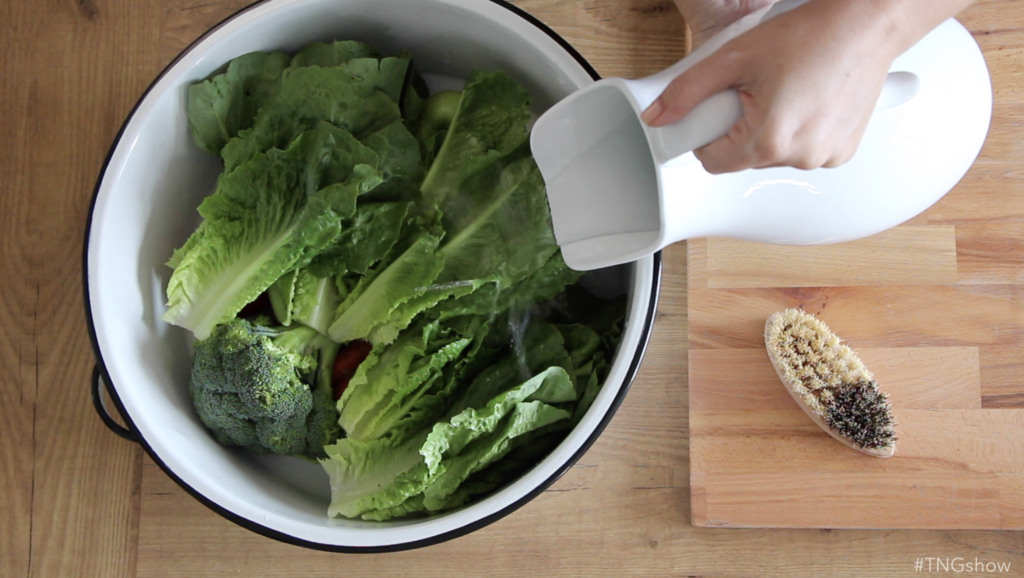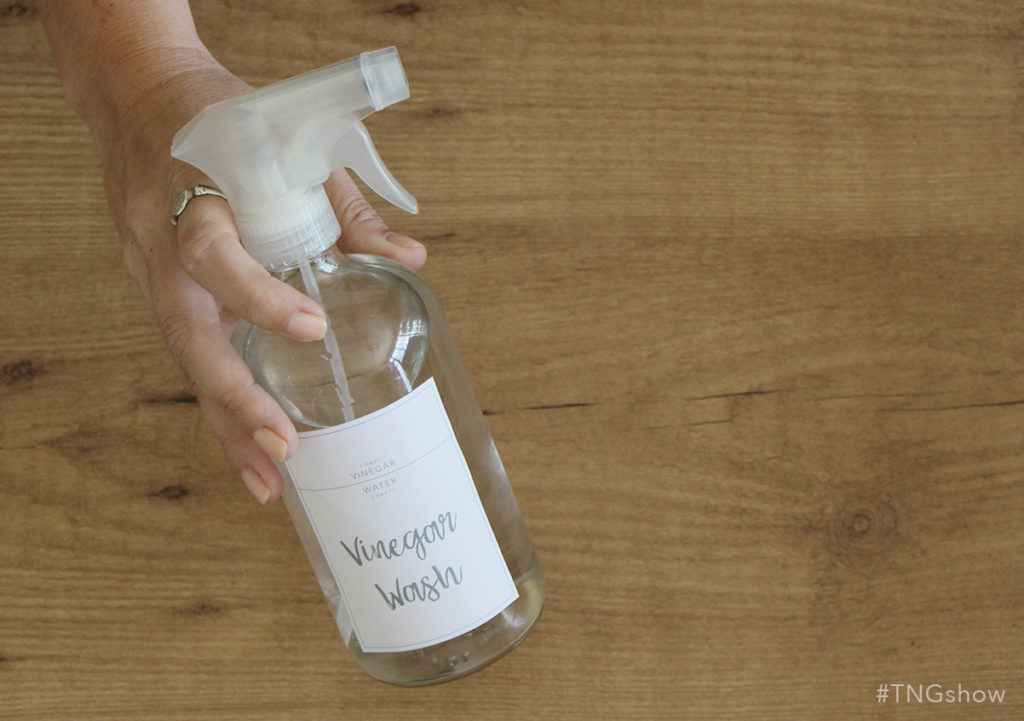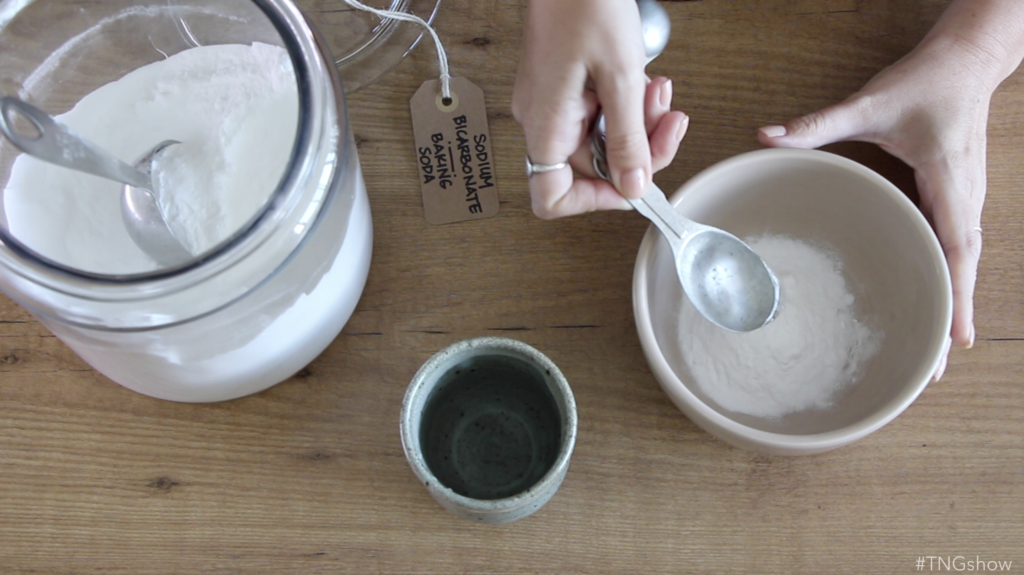Today we’re washing fruits and veggies. So, why bother? Well, there’s a couple of reasons…
Most produce is grown outside and in soil so inevitably there will be soil particles and the occasional bug that you’ll want to rinse off. But more than that, produce, even organic produce, can have soil microbes on the surface and accidental contamination can occur in any number of places, including from the other people that touched your perfect apple before you did – and one can only hope that they all washed their hands properly. So now that I’ve given you something to think about, let’s wash this stuff, shall we?
Depending on how much produce you’re washing you can either do the spray method or the soak method.
The Soak Method

This is good if you have a lot of produce to wash or for veggies with a lot of crevices like broccoli or cauliflower and I also like to clean lettuces this way. Start by putting your fruits and veggies in a large basin or your clean sink.
- MIX together 4 parts cool water to 1 part white vinegar and pour it over your produce. The acetic acid in the vinegar is an antimicrobial and it’ll help kill off more of the microbe nastiness that could be on your produce.
- SOAK your fruits and veggies in the vinegar rinse – about 2 minutes for softer fruits and veggies and up to 10 minutes for harder or thick-skinned veggies like cucumbers or melons.
- SCRUB thick-skinned and hard fruits and veggies with a stiff-bristled brush to remove any excess dirt.
- RINSE & DRY. When your produce is done soaking, rinse it in cool water and pat dry with a clean towel.
Now I’m sure you’re wondering, does the vinegar leave a taste behind? I haven’t found that it does, the water to vinegar ratio seems to be enough that the taste doesn’t linger. But if you don’t feel comfortable using the vinegar you can still get a lot of benefit just by washing your produce this way in plain water.
The Spray Method
Now if you’ve got a smaller amount of produce to wash or fruits that are porous, like berries, you can use the spray method instead.
 Download this Vinegar Wash label
Download this Vinegar Wash label
- BOTTLE. Add the vinegar rinse (still 4 parts water to 1 part vinegar) to a spray bottle. For this method I like to use distilled water because I’ll be storing the extra rinse for later and I want as pure a water as possible in there. For the soak method you can just use tap or filtered water.
- SPRAY your produce liberally with the rinse. If you’re doing just a piece or two you can hold it in your hand, spray, and rub it around for 1-2 minutes.
- RINSE & DRY. When you’re done, rinse the produce in cool water and pat dry with a clean towel.
If you’re washing berries then the best method is to pop them into a colander, spritz and toss them a bit, then allow them to sit for 1-2 minutes before rinsing. Berries can soak up water quickly and lose flavor so you don’t want to soak them in water.
BONUS: Baking Soda Scrub
A quick note on pesticides…
Most fruits and veggies have been sprayed with some form of pesticide and possibly an herbicide and while you can’t always wash them completely away (because that stuff can pass through the skin of some produce) you can wash away any excess. Some pesticides are water soluble so a good rinse and scrub, with a stiff-bristled brush or baking soda, in clean water can do the job.

- MIX together 3 parts baking soda to 1 part water to form a paste.
- SCRUB your produce with the paste, the baking soda can help remove excess pesticides.
A quick note: I don’t mix the baking soda and vinegar rinse together because the fun volcano of bubbles that occurs can actually lessen the effectiveness of each product. If you want to do both the scrub and the vinegar wash, I suggest doing the scrub first, then rinse and do the vinegar wash. If you’re only going to do one, then it’s up to you, but I’d pick the vinegar wash.
So that’s all there is to it! You should always rinse your fruits and veggies even if they’re organic. And definitely continue to eat as many fruits and veg as you can – even if they’re not organic because those little buggers sure are good for ya.
You can check out this year’s Dirty Dozen list. It shows you the fruits and veggies with the most, and least, amount of excess pesticides so you can best choose where to spend your organic dollars.
Alright! I’ll see you next week with a natural cleaning DIY so be sure to subscribe to the The Normal Girl Show so you don’t miss it! This month is all about natural cleaning and home care so be sure to stay tuned!
Let me know in the comments, or tweet me, if you give this a try and until next time…stay normal!
-Katie
